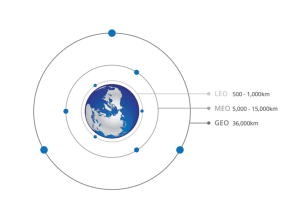The concept of nano satellite orbit has become central to space exploration, offering new possibilities for data collection, communication, and Earth observation. As the need for low-cost, high-frequency data from space increases, nano satellites have emerged as a solution capable of performing complex tasks at a fraction of the size and cost of traditional satellites.

What is Nano Satellite Orbit
Nano satellite orbit refers to the specific paths that nano satellites take as they circle the Earth. Defined by key parameters like altitude, inclination, and speed, these orbits allow nano satellites to achieve unique mission goals. Nano satellites, weighing between 1 and 10 kilograms, often utilize Low Earth Orbit (LEO), where they can perform a range of applications effectively. In LEO, these small satellites can capture high-resolution images, track environmental changes, and support global connectivity projects.
Key Types of Nano Satellite Orbits
Different types of orbits serve distinct functions for nano satellites. The most common orbits include:
Low Earth Orbit (LEO)
Low Earth Orbit, or LEO, is the most frequently used orbit for nano satellites, positioned between 180 and 2,000 kilometers above Earth. Due to its proximity to Earth, LEO offers high-resolution imaging and quick data relay, which is essential for applications such as Earth observation and environmental monitoring. Nano satellites in LEO can circle the Earth multiple times daily, allowing for near-real-time data collection.
Sun-Synchronous Orbit (SSO)
The Sun-Synchronous Orbit (SSO) is another popular option for nano satellites, particularly those used in Earth observation. Positioned at an angle that allows satellites to pass over the same region at the same solar time, SSO enables consistent lighting conditions for imaging. This is advantageous for tasks requiring detailed analysis of Earth’s surface over time, as it provides a stable basis for comparison.
Polar Orbit
Nano satellites in polar orbits pass over the Earth’s poles, enabling full global coverage as the planet rotates beneath them. These orbits are useful for comprehensive Earth observation missions, where satellites capture data from every latitude. Nano satellites in polar orbits contribute valuable information to climate monitoring and resource mapping efforts.
Geostationary Transfer Orbit (GTO)
While less common for nano satellites, Geostationary Transfer Orbit (GTO) can be used as an intermediate orbit for nano satellites intended to reach Geostationary Orbit (GEO). In GTO, nano satellites can gradually shift into higher orbits, extending their mission reach. However, the complexity and fuel requirements typically restrict GTO usage to specific mission types.
Factors Determining Nano Satellite Orbit Choice
Selecting an orbit for a nano satellite depends on a range of factors, each impacting mission success. Key considerations include:
Mission Objectives
The primary mission objectives often dictate which orbit best suits the satellite. Earth observation missions favor LEO and SSO for their proximity and lighting conditions. For missions requiring global coverage, polar orbits provide a comprehensive solution.
Lifetime and Cost
Lower orbits like LEO have shorter satellite lifetimes due to atmospheric drag, resulting in gradual orbital decay. However, launching to LEO is often less costly and better suited for short-term or frequent missions, making it an attractive choice for nano satellite operators focused on budget-friendly solutions.
Data Transfer Requirements
The choice of orbit also impacts data transfer capabilities. LEO, for example, supports high-speed data relays, ideal for frequent updates. Conversely, polar and SSO orbits enable targeted data collection over specific regions. Selecting the right orbit can ensure optimal data transfer rates and minimize latency.
Applications Leveraging Nano Satellite Orbits
Nano satellites have revolutionized data collection across industries, from environmental research to telecommunications. Here are some notable applications:
Earth Observation and Imaging
Nano satellites in LEO and SSO are frequently used for Earth observation and imaging. By capturing high-resolution images, they support environmental monitoring, disaster response, and resource management. With their ability to revisit specific areas frequently, nano satellites provide continuous updates that support informed decision-making.
Global Connectivity
Telecommunication providers are increasingly using nano satellites to expand global internet access. By deploying constellations in LEO, nano satellite operators can provide high-speed connectivity in regions lacking reliable terrestrial infrastructure. As these networks grow, nano satellites are helping to bridge the digital divide worldwide.
Climate Monitoring and Research
Climate scientists rely on nano satellites in polar and SSO orbits to collect data on atmospheric and environmental conditions. These orbits allow for consistent data collection, supporting studies on global warming, weather patterns, and ecosystem changes. Nano satellites play a critical role in monitoring phenomena like deforestation, glacial retreat, and rising sea levels.
Benefits of Using Nano Satellites in Various Orbits
Nano satellites offer several advantages when deployed in carefully selected orbits. Their small size and lower launch costs make them ideal for rapid deployment, and their flexibility allows operators to choose orbits that align with mission requirements.
- Cost Efficiency: Launching nano satellites is typically more cost-effective than deploying larger satellites, enabling frequent launches for multi-purpose data collection.
- Frequent Revisit Rates: LEO and SSO orbits allow nano satellites to revisit specific areas multiple times daily, ensuring timely and reliable data updates.
- Scalability: Nano satellites are often deployed in constellations, increasing coverage and providing a redundant system that enhances data reliability and reduces service interruptions.
Challenges Facing Nano Satellite Orbits
While nano satellites offer numerous benefits, there are challenges related to orbital choices. In lower orbits like LEO, atmospheric drag can cause satellites to decay faster, necessitating more frequent replacements. Additionally, the rapid growth of satellite constellations has raised concerns about space debris and orbital crowding, highlighting the need for sustainable satellite management practices.
The choice of nano satellite orbit requires a balance between mission goals, cost, and sustainability. By carefully selecting orbits and managing satellite lifetimes, operators can maximize data quality and ensure long-term value for a broad range of applications. Nano satellites continue to shape the future of space missions, making orbit selection a key factor in mission success.
